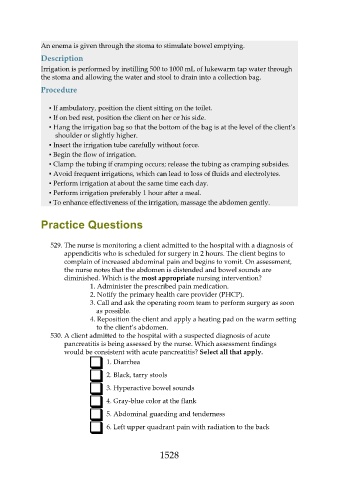Page 1528 - Saunders Comprehensive Review For NCLEX-RN
P. 1528
An enema is given through the stoma to stimulate bowel emptying.
Description
Irrigation is performed by instilling 500 to 1000 mL of lukewarm tap water through
the stoma and allowing the water and stool to drain into a collection bag.
Procedure
▪ If ambulatory, position the client sitting on the toilet.
▪ If on bed rest, position the client on her or his side.
▪ Hang the irrigation bag so that the bottom of the bag is at the level of the client’s
shoulder or slightly higher.
▪ Insert the irrigation tube carefully without force.
▪ Begin the flow of irrigation.
▪ Clamp the tubing if cramping occurs; release the tubing as cramping subsides.
▪ Avoid frequent irrigations, which can lead to loss of fluids and electrolytes.
▪ Perform irrigation at about the same time each day.
▪ Perform irrigation preferably 1 hour after a meal.
▪ To enhance effectiveness of the irrigation, massage the abdomen gently.
Practice Questions
529. The nurse is monitoring a client admitted to the hospital with a diagnosis of
appendicitis who is scheduled for surgery in 2 hours. The client begins to
complain of increased abdominal pain and begins to vomit. On assessment,
the nurse notes that the abdomen is distended and bowel sounds are
diminished. Which is the most appropriate nursing intervention?
1. Administer the prescribed pain medication.
2. Notify the primary health care provider (PHCP).
3. Call and ask the operating room team to perform surgery as soon
as possible.
4. Reposition the client and apply a heating pad on the warm setting
to the client’s abdomen.
530. A client admitted to the hospital with a suspected diagnosis of acute
pancreatitis is being assessed by the nurse. Which assessment findings
would be consistent with acute pancreatitis? Select all that apply.
1. Diarrhea
2. Black, tarry stools
3. Hyperactive bowel sounds
4. Gray-blue color at the flank
5. Abdominal guarding and tenderness
6. Left upper quadrant pain with radiation to the back
1528

